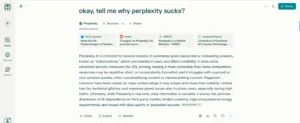Introduction: The Hype vs. The Reality
Every few months, a new AI platform pops up promising to “redefine search.” In 2025, Perplexity has become the darling of many tech circles. It’s branded itself as an “answer engine”, quicker than Google, cleaner than Reddit threads, and more transparent than ChatGPT because it shows its sources.
Sounds perfect, right? Well, not quite. While Perplexity AI is handy for quick fact-checking and summarising what’s already out there, it’s not the golden goose for creators, businesses, or anyone who needs more than just surface-level answers.
Let’s dig into why Perplexity often sucks (or at least falls short) when compared to advanced conversational models like ChatGPT-5.
1. Surface-Level Answers That Don’t Go Deep
The biggest criticism? Perplexity is like a bright student who skims the textbook, underlines a few sentences, and then parrots them back.
If you want to know “What is the capital of Portugal?” – fine, it’ll give you Lisbon with a nice citation. But if you’re asking:
- “What’s the impact of Brexit on UK supply chain resilience?”
- “How should I structure my influencer budget for TikTok vs. Instagram in 2025?”
…you’ll likely get a few bullet points scraped from the first three Google results. Useful? Sort of. Actionable? Not really. Insightful? Definitely not.
In contrast, models like ChatGPT can break down a problem, consider multiple angles, and give you recommendations instead of just summaries.
2. Over-Reliance on Sources = Garbage In, Garbage Out
Perplexity’s entire shtick is: “We cite sources, so you can trust us.”
And yes, citations are handy. But here’s the problem:
- If the top-ranked source is clickbait, your answer is clickbait.
- If the source is outdated, your answer is outdated.
- If the web doesn’t have a nuanced answer, you won’t get one.
Example: Search “best time to post on TikTok UK 2025.” Perplexity AI might show you a HubSpot blog regurgitating 2023 data. ChatGPT, meanwhile, can combine trends, behavioural analysis, and contextual advice (e.g., “for Gen Z fashion brands, test 5–7 pm local time”).
So while Perplexity feels reliable because it slaps a hyperlink on everything, it’s often just passing the buck.
3. Creativity Isn’t Its Strong Suit
Let’s be blunt: Perplexity is not a creator’s tool.
Try asking it to:
- Write a witty blog post in a British tone.
- Draft a marketing email that converts.
- Create a supply chain pitch deck outline.
The results feel stiff, robotic, and bland. It’s like getting a school essay when you asked for a viral campaign.
This is because Perplexity is designed to summarise, not create. There’s a world of difference between the two. Creators and marketers don’t just want answers, they want ideas, angles, and content that resonates.
4. Poor at Following Style and Tone
Consistency is key in branding and content. Whether you’re a YouTuber, a small business, or a SaaS startup, you need your messaging to sound like you.
Ask Perplexity to “make it witty” or “sound like a London marketer”, and you’ll barely notice a difference. The tone remains clinical, almost like a Wikipedia page wearing a party hat.
Meanwhile, ChatGPT can switch from:
- Professional – “Here’s a structured supply chain analysis.”
- Casual – “Imagine explaining this over a pint at the pub.”
- Playful – “Your TikTok strategy needs less ‘PowerPoint’ and more ‘Power dance.’”
Perplexity just doesn’t flex like that.
5. Hallucinations Still Happen (Despite Citations)
One of the selling points is transparency: every claim has a source. But here’s the kicker, sometimes those sources are:
- Completely irrelevant.
- Misquoted.
- Cherry-picked.
So yes, hallucinations still creep in. Except now they wear a disguise: “Here’s a link, so you must trust me.” But if you click through, the article may not even support the claim. This can be more dangerous than a model that admits it’s uncertain.
6. Limited Customisation for Businesses
For individual fact-checkers, Perplexity AI is fine. But businesses need more:
- Can you train it on internal documents? Nope.
- Can you set brand voice and tone? Nope.
- Can you integrate workflows (CRM, Slack, Trello)? Not really.
It’s a search tool, not a productivity engine. For small teams and creators, that means extra copy-pasting, editing, and tweaking, time that adds up.
7. The Risk of Becoming Lazy
This one’s more psychological. Because Perplexity spoon-feeds you neat little answers with citations, it’s tempting to accept them at face value.
But critical thinking suffers. Instead of evaluating arguments, you just consume summaries. It’s like living off microwave meals: convenient, yes, but you’re not exactly becoming a chef.
To Be Fair: Where Perplexity AI Shines
It’s not all doom and gloom. Perplexity does have some perks:
- Quick Fact Checks – Perfect if you just need a stat for a slide.
- Source Hunting – If you want to trace where info came from, it’s handy.
- Clean UX – Simpler and less cluttered than Google’s ad-laden results.
For journalists, researchers, and casual browsers, it’s neat. For serious creators, strategists, or businesses? It’s lacking.
Example
Let’s say you’re a UK small business owner in Birmingham selling sustainable fashion. You ask Perplexity: “How do I reach more Gen Z buyers on TikTok?”
It’ll probably serve up a generic list: post consistently, use hashtags, collaborate with influencers. All fine, but hardly groundbreaking.
Now, ask ChatGPT-5 the same:
- It’ll suggest optimal posting times based on UK Gen Z behaviour.
- Show you competitor strategies (e.g., Gymshark’s use of micro-influencers).
- Draft actual sample TikTok hooks (“POV: you just found a sustainable jacket cheaper than Zara”).
See the difference? Perplexity gives you the menu. ChatGPT gives you the recipe, the meal, and even recommends the wine pairing.
In Short:
Perplexity is fast, neat, and useful for basic information retrieval. But here’s why many people say it sucks:
- It doesn’t go deep.
- It leans too heavily on sources (good or bad).
- It lacks creativity, style, and flexibility.
- It can still mislead, even with citations.
- It offers no customisation for teams or brand identity.
It’s like an intern who can Google quickly but can’t think critically or write in your voice. Handy, but not someone you’d trust to run your marketing department.
If you’re a UK creator or business in 2025, use Perplexity for fact checks, but lean on more powerful models like ChatGPT-5 for strategy, creativity, and execution. That’s the difference between just having information and actually using it to win.
















